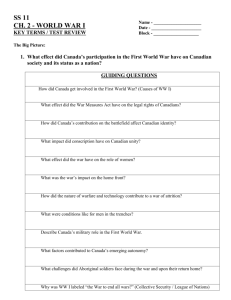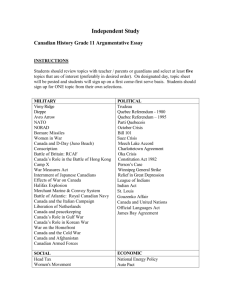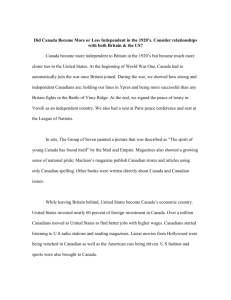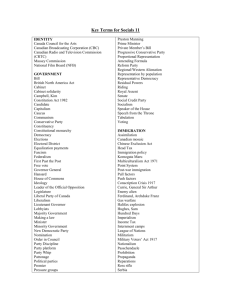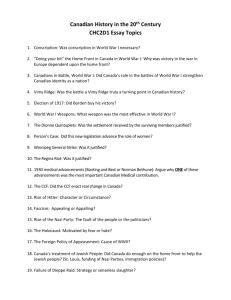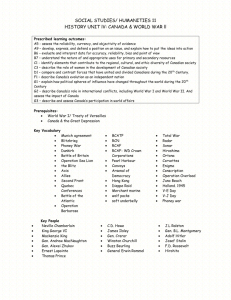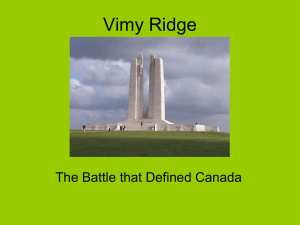Social Studies 11
advertisement
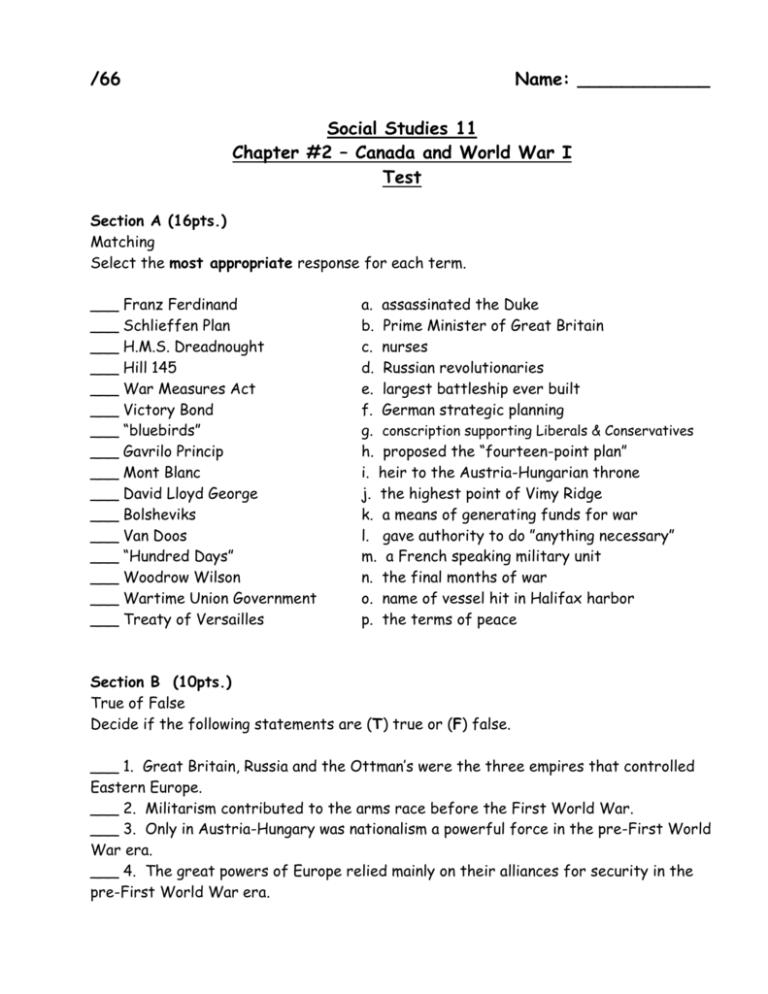
/66 Name: ____________ Social Studies 11 Chapter #2 – Canada and World War I Test Section A (16pts.) Matching Select the most appropriate response for each term. ___ ___ ___ ___ ___ ___ ___ ___ ___ ___ ___ ___ ___ ___ ___ ___ Franz Ferdinand Schlieffen Plan H.M.S. Dreadnought Hill 145 War Measures Act Victory Bond “bluebirds” Gavrilo Princip Mont Blanc David Lloyd George Bolsheviks Van Doos “Hundred Days” Woodrow Wilson Wartime Union Government Treaty of Versailles a. assassinated the Duke b. Prime Minister of Great Britain c. nurses d. Russian revolutionaries e. largest battleship ever built f. German strategic planning g. conscription supporting Liberals & Conservatives h. proposed the “fourteen-point plan” i. heir to the Austria-Hungarian throne j. the highest point of Vimy Ridge k. a means of generating funds for war l. gave authority to do ”anything necessary” m. a French speaking military unit n. the final months of war o. name of vessel hit in Halifax harbor p. the terms of peace Section B (10pts.) True of False Decide if the following statements are (T) true or (F) false. ___ 1. Great Britain, Russia and the Ottman’s were the three empires that controlled Eastern Europe. ___ 2. Militarism contributed to the arms race before the First World War. ___ 3. Only in Austria-Hungary was nationalism a powerful force in the pre-First World War era. ___ 4. The great powers of Europe relied mainly on their alliances for security in the pre-First World War era. ___ 5. The Canadian Ross Rifle was one of the best combat rifles in the First World War. ___ 6. Canadian forces fought independent of British influence in the First World War. ___ 7. The machine gun made it almost impossible to attack the enemy. ___ 8. Most countries in the First World War used conscription to ensure they had enough soldiers. ___ 9. Canada used censorship during the First World War. ___10. The role of women in society changed very little during the First World War. Section C (25pts.) Multiple Choice Circle the most appropriate answer. 1. Which nations made up the Triple Alliance? a. France, Great Britain, Italy b. Austria-Hungary, Russia, Turkey c. France, Great Britain, Russia d. Austria-Hungary, Germany, Italy 2. The weapon which had the greatest impact upon the front line trenches was a. the machine gun. b. aircraft. c. poison gas. d. the tank. 3. Which Canadian regiment suffered a 90% casualty rate on the first day of the Battle of the Somme? a. Canadian Expeditionary Force b. Newfoundland c. Royal Highlanders d. Vandoos 4. Which Canadian sharp shooting rifle was abandoned by front line soldiers in favour of a different, British model? a. Ross b. Enfield c. Maxim d. Vickers 5. Which of the following promotes the belief that one’s ethnic group is more important than others? a. Communism b. Socialism c. Democracy d. Nationalism 6. Which Prime Minister introduced the Conscription Act in 1917 in order to meet recruitment levels that had dropped off sharply? a. Wilfred Laurier b. Henri Bourassa c. Robert Borden d. John A. MacDonald 7. The Canadian fighter ace that shot down the Red Baron was a. Bill Collishaw. b. Billy Barker. c. Billy Bishop. d. Roy Brown. 8. A significant shift in industrialized countries during the First World War was a. a decrease in taxation. b. the employment of women in many types of jobs. c. less government interference in their economies. d. massive war protests. 9. Upon the entrance of Great Britain, which country automatically joined the First World War? a. Belgium b. Canada c. United States d. Italy 10. In Canada, the War Measures Act of 1917 a. ended the Chinese head tax. b. gave the government the right to send women into combat. c. reduced income tax. d. placed restrictions on enemy aliens. 11. The first battle in which Canadian troops fought as a national unit was a. Passchendaele. b. Vimy Ridge. c. The Battle of the Somme. d. Yres. 12. The battle in which chlorine gas was used for the first time by the Germans was a. Passchendaele. b. Vimy Ridge. c. The Battle of the Somme. d. Yres. 13. The battle in which tanks were used for the first time was a. Passchendaele. b. Vimy Ridge. c. The Battle of the Somme. d. Yres. 14. Imperialism contributed to the cause of the First World War by a. evenly distributing the available territories. b. causing the great powers to fight many wars against their colonial subjects. c. bringing European powers into competition for territories. d. introducing restrictions on immigration from the colonies. 15. Which nations made up the Triple Entente? a. Austria-Hungary, Germany, Italy b. Austria-Hungary, Russia, Turkey c. France, Great Britain, Russia d. France, Great Britain, Italy 16. Which of the following was the name of the Minister of Militia? a. Tom Longboat b. Tim Longboat c. Sam Hughes d. John Hughes 17. Which piece of legislation, passed in 1917, allowed the Canadian government to make enlistment in the Canadian army compulsory for all able-bodied men between the ages of 20 and 45 years? a. Military Service Bill b. Military Voters’ Act c. Wartime Elections Act d. Wartime Voter’s Act 18. Who was the Prime Minister of Canada during the First World War? a. Aurthur Meighen b. Henri Bourassa c. Wilred Laurier d. Robert Borden 19. The introduction of conscription in Canada in 1917 caused a serious rift between a. the army and the government. b. French and English Canadians. c. the federal government and all provincial governments. d. the Prime Minister and his party. 20. Germany’s attack on France in 1914 was halted at what battle? a. The Battle of the Somme b. Vimy Ridge c. Yres d. Passchendaele 21. The title under which most Canadian forces fought was called the a. Canadian Overseas Battle Group. b. Canadian Foreign Army. c. Canadian Legionnaires. d. Canadian Expeditionary Force. 22. The term that best describes the practice of occupation and exploitation of foreign lands for wealth and power is a. Imperialism. b. Socialism. c. Nationalism. d. Communism. 23. “Over the top”, “no man’s land”, and “battles of attrition” are all terms related to which of the following? a. Holding a blockade b. Submarine warfare c. Air strikes d. Trench Warfare 24. In 1917, the Allies received a great boost in their morale when which of the following countries declared war on Germany? a. The United States b. Italy c. Russia d. Canada 25. One disastrous result of the Treaty of Versailles was its a. introduction of democracy in Germany. b. failure to make Germany pay reparations. c. giving the French everything they wanted. d. contribution to the causes of the Second World War. Section D (12pts.) Essay On a piece of lined paper, discuss the ways in which Canada as a nation matured as a result of the First World War. Be sure that you address the issue of essay writing correctly. Hint: Introduction with a clear thesis statement, three supporting paragraphs (evidence to prove your thesis), and a conclusion. Brainstorm here: (3 pts.)

